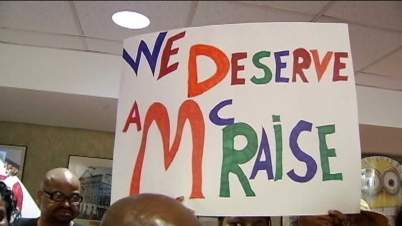topics/coal
This hour we speak with artists, musicians, and activists from different parts of the southern Appalachian region about the intersections between their art and activism. Our guests are all taking part in the Common Ground On the Hill festival, taking place right now in Westminster, Maryland.
This hour we feature two perspectives on transitioning to cleaner sources of energy.
Today's show began with another look at the future of journalism. Senator Ben Cardin discussed his bill that would allow newspapers to operate as nonprofits. Then Walter Isaacson, the former Chairman and CEO of CNN and former managing editor of Time, shared his take on the future of news.
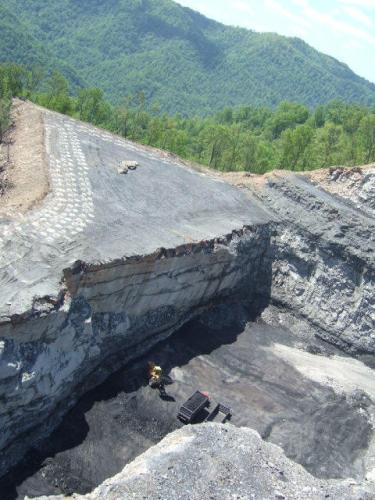
Kayford Mountain, West Virginia (photo: Justin Levy)
One point of agreement between the McCain and Obama campaigns was their support of the coal industry, or what they call "clean coal." Have you been wondering what "clean coal" means?
Today, we discuss our energy future. What are the costs of our dependence on coal, and what alternatives are we developing?
We'll be joined in studio by Dave Cooper, a resident of Kentucky and the host of the Mountaintop Removal Road Show. We'll also be joined on the phone from West Virginia by Lorelei Scarbro, an organizer working on the Coal River Wind Project, a wind farm proposed by the community as an alternative to the mining company's plan to open another mountaintop removal site on Coal River Mountain.
Also featured this hour is a short interview with Larry Gibson that we recorded on Kayford Mountain in West Virginia, where he lives, last spring. We walked through the woods to a steep precipice where we could see the active mountaintop removal mining site that has destroyed the land his family has lived on for centuries.
For more of our coverage on coal issues, click here.
The Marc Steiner Show for Wednesday July 23rd will include three topics:
The show will begin with a conversation about the ACLU's allegations that the Maryland State Police spent hundreds of hours in 2005 and 2006 infiltrating and spying on anti-death penalty and peace groups in Baltimore. Marc will speak to:
- David Rocah, attorney for the ACLU
- Max Obuszewski, peace activist
- Maria Allwine, peace activist
- The Maryland State Police were invited but have declined the invitation.
*After the show today, we recorded a short interview with Maryland Senator Ben Cardin that followed up on this discussion. Please click here to listen to his thoughts on the spying issue.
The show will then move to a look at coal mining and how practices like mountain top removal are changing Appalachia and the lives of the people who live there. Marc will talk to:

- Debbie Jarrel, lifetime resident of West Virginia's Coal River Valley and an anti-mountain top removal activist.
To learn more about mountaintop removal, go to our forum for a great list of links, as well as more info and discussion. Also, check out these posts on our blog from our trip to West Virginia: post1 post2 post3
Finally, we'll broadcast an excerpt of Marc's interview with a textile artist whose pieces made of hair are currently being exhibited at the Walters Art Museum. Marc will talk with:
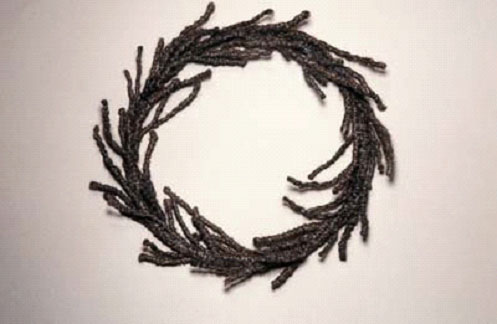
- Sonya Clark, Chair/Professor in the Craft and Media Studies department at VCU School of the Arts in Richmond, VA.


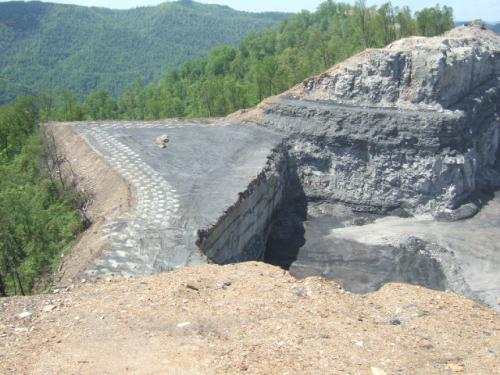
These are photos I took looking out across an active mountain removal site on Kayford Mountain in West Virginia. It's hard to get a feel for the size of the mining site without being there. It's even harder to imagine what it looked like in its natural state, but look at the dark green, tree-covered hills all around it to get some idea.
We'll be bringing you more about what's happening on Kayford Mountain soon, but I wanted to get these images out there right away. Larry Gibson showed us around here. He grew up on Kayford Mt. and now the land his family and others lived on for generations is being irreparably destroyed. He came with his cousin that day to mow the grass in two family cemeteries that are here. We walked past them on the way to what is now a cliff over the mining site where I stood and took these pictures. Another of their cemeteries has already been destroyed by the mining company as they've blasted the mountain apart and carted away ton after ton of coal from inside of it.
Larry told us not to waste his time. He wasn't showing us around for no reason; he wanted to make sure we were going to do something about what we saw. Larry is for abolishing the use of coal altogether, despite having family members who work in the industry and are upset by his stance. Unlike many people we spoke to who expressed support for continuing mining in a responsible, less destructive manner, Larry told us he doesn't believe it's possible to mine and use coal in a way that is not harmful.
Over and over again last week, people mentioned supporting the Clean Water Protection Act as the most important thing anyone can do right now to help bring an end to mountaintop removal. Contact your Congressmen and make sure they support it!
Please also check out our new forum on mountaintop removal, and these two blog posts from West Virginia last week - 1 & 2.
-Justin
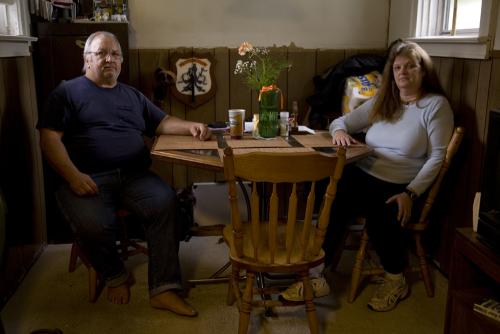
We spent our first full day in West Virginia visiting people in their homes, taping interviews. People shared incredible stories with us that we'll be bringing back. I recorded about 6 hours of audio today alone. We saw a 90 year-old woman's fingers turn black with coal dust from running them across her tv screen. Again and again, people expressed their respect for the old ways of underground mining. At the same time, they spoke with outrage about mountaintop removal and the unprecedented level of destruction coal companies have caused in this area over the past 25 years or so.
Antrim took this picture of Patty Sebok and her husband Harry "Butch" Sebok in their kitchen. Patty is a community activist who works for Coal River Mountain Watch. Butch is a union miner who worked underground for almost 30 years. He was forced to retire when a doctor told him he risked paralysis if he continued working after an injury on the job that resulted in a herniated disk.
We'll be up bright and early in the morning to tape some more interviews before heading up Kayford Mountain to see an active mountaintop removal site and meet the last man holding onto his home as the mountain is destroyed all around it. I encourage everyone to do their own research to learn more about mountaintop removal and the history of coal mining in West Virginia and beyond. Please let us know if you have any questions or thoughts to share.
-Justin
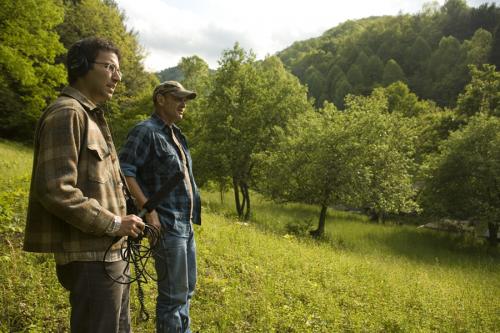
When we flip on a power switch in our homes, where does the electricity come from? How is it generated? There's a good chance it's from a coal-fired power plant. Click here for an easy way to trace your power source with nothing more than your zip code. With all the talk of developing new, sustainable energy sources, we're still relying heavily on the old standbys like oil and coal.
Last November on The Marc Steiner Show, we had a coal industry spokesperson and a group of West Virginia residents as guests on the show to discuss coal mining. The conversation centered around mountaintop removal, one of the most widespread and quickly growing methods of mining coal in use today.
We were all blown away by what we learned in the process of putting that show together, and since then we've been wondering why this issue hasn't been getting the attention it deserves. So, we decided that it's something we should keep an ongoing focus on. Look for us to have continuing coverage both on this website and on the air.
Rather than covering the issue from afar, we decided to go straight to the source. This morning, I set out for the coal fields of southern West Virginia, along with photojournalist Antrim Caskey, who's been working for the past 3 years to get people to pay attention to and do something about the environmental, including human, destruction caused by modern day coal mining practices in Appalachia. We'll be spending this week down here lining up as many people as possible to contribute first-hand coverage to CEM on an ongoing basis. We'll also be coming back with tons of new audio, photos, and video.
We're spending the night in the Coal River Valley with Debbie Jarrel and Ed Wiley. You'll hear a lot more about and from them if you stay with us here, for now check out one of the major projects they've been involved with, advocating for the safety and health of the students, teachers, and staff of Marsh Fork Elementary School. This site is full of info on that; briefly, it's a school down the road from them sitting right down the hill from a huge, leaky sludge impoundment, or what Ed describes as a 2.8 billion gallon toxic waste dump.
The picture at the top is from this afternoon, during a beautiful hike Ed took us on in the woods behind his home. The pictures below are from this evening. They're taken from the road, as we drove past an area being cleared by a coal company to put in a new beltline to transfer coal from the mining site to the processing plant.
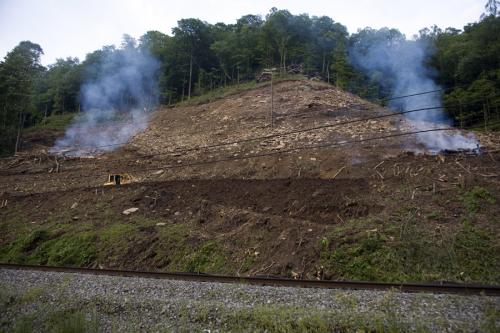
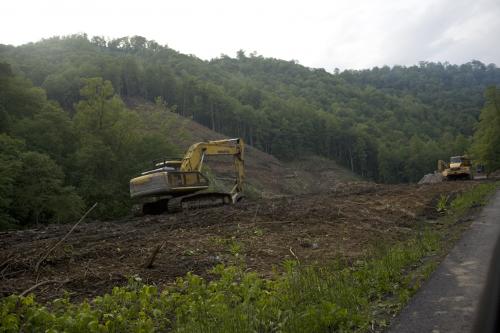
This has been an interesting week. First, the Peabody Award comes for our work on the series we produced called Just Words. It was funded by the Open Society Institute and aired on WYPR for a little over a year. We submitted the work for the prestigious Peabody but had no expectations of winning one.

*click here to listen to this show (might take a minute to load)


